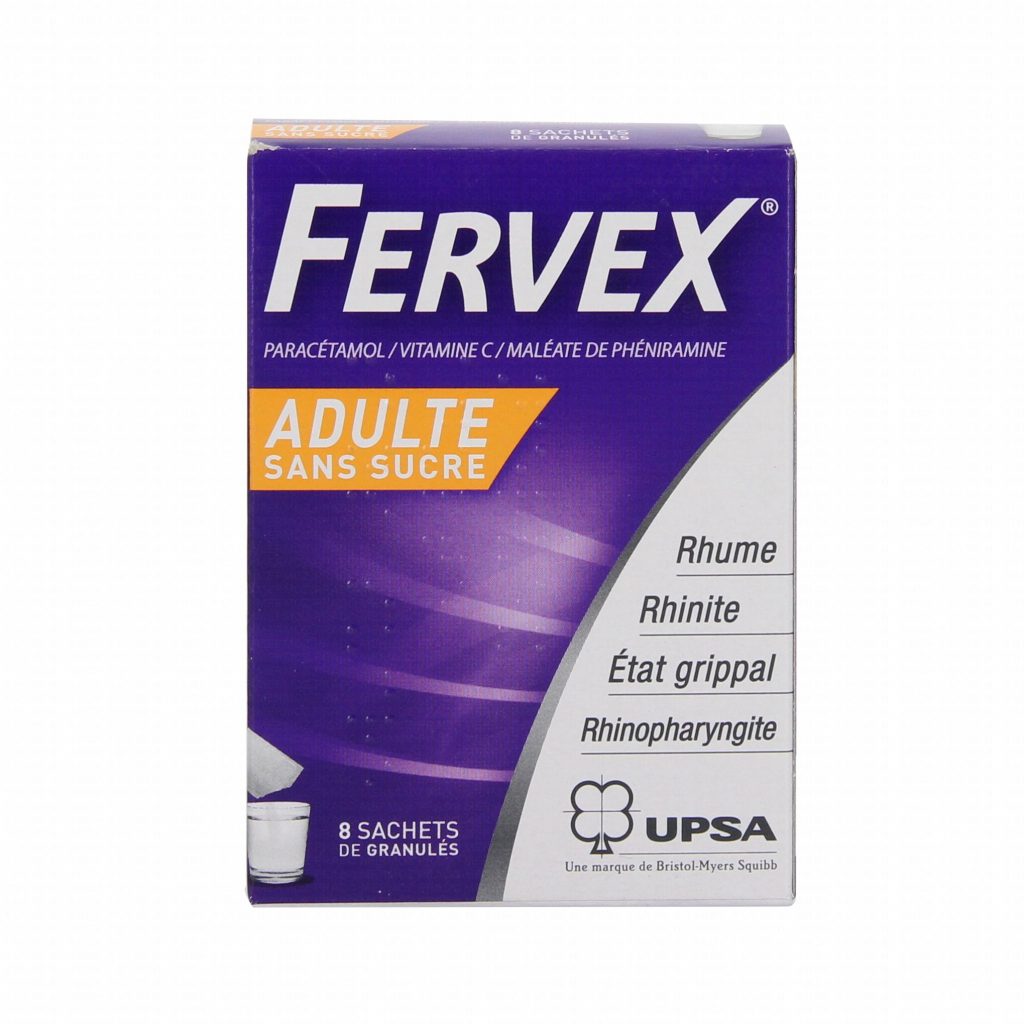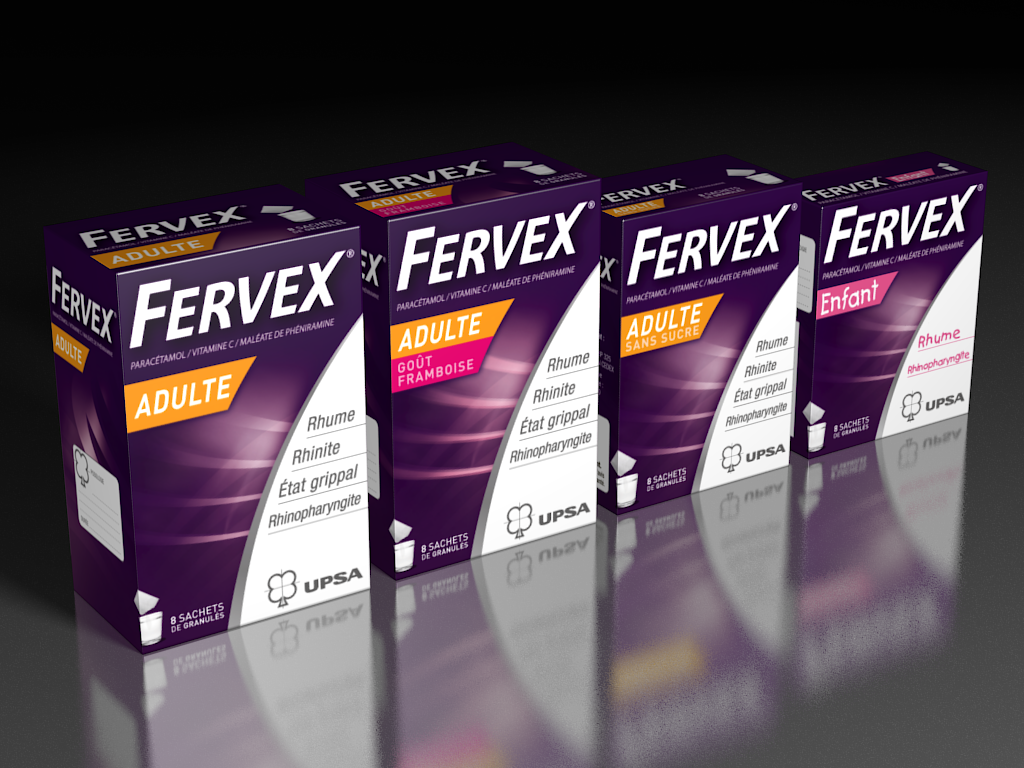Fervex Upsa
Pharmachologic effect
Combination drug for symptomatic therapy of acute fervex upsa respiratory disease.
Paracetamol – an analgesic-antipyretic, has an analgesic and antipyretic effect, which is associated with its influence on the center of thermoregulation in the hypothalamus; eliminates headache and other types of pain, reduces fever.
Ascorbic acid (vitamin C) is involved in the regulation of oxidation-reduction processes, carbohydrate metabolism, blood coagulation, tissue regeneration, synthesis of GCS, collagen and procollagen; normalizes the permeability of capillaries. Increases the resistance of the body, which is associated with the stimulation of the immune system.
Phenyramin – a blocker of histamine H 1 -receptors, fervex upsa reduces rhinorrhea, a feeling of nasal congestion, sneezing, lacrimation, itching and redness of the eyes.
Clinical and pharmacological group

Pharmacokinetics
Data on the pharmacokinetics of the Fervex preparation are not available.
Indications for use of the drug
– ARVI (symptomatic therapy);
– Rhinopharyngitis.
Dosing regimen
Ferveks designate the inside of 1 packet 2-3 times / day. preferably between meals. The interval between doses of the drug is at least 4 hours.
In patients with impaired liver or kidney function and elderly patients, the interval between doses should be at least 8 hours.
Duration of treatment (without consulting a doctor) is no more than 5 days when used as an analgesic and not more than 3 days – as an antipyretic.
The drug should be completely dissolved in a glass of warm water and fervex upsa the resulting solution immediately drink.
Side effect
From the digestive system: nausea, pain in the epigastric region; rarely dry mouth; with prolonged use in doses significantly exceeding the recommended, increases the likelihood of impaired liver function.
From the hemopoietic system: rarely – anemia, thrombocytopenia, methemoglobinemia.
From the urinary system: rarely – urinary retention; with prolonged use in doses significantly exceeding the recommended, the probability of impaired renal function increases.
Allergic reactions: skin rash, itching, urticaria, angioedema.
Other: rarely – paresis of accommodation, drowsiness.
The drug is well tolerated at recommended doses.
Contraindications to the use of the drug
– erosive-ulcerative lesions of the gastrointestinal tract (in the phase of exacerbation);
– kidney failure;
– portal hypertension;
– chronic alcoholism;
– deficiency of glucose-6-phosphate dehydrogenase;
– children’s age till 15 years;
– I and III trimesters of pregnancy;
– lactation period (breastfeeding);
– Hypersensitivity to the components of the drug.
With caution should be used in patients with liver failure, zakratougolnoy glaucoma, prostatic hyperplasia, congenital fervex upsa hyperbilirubinemia (syndromes Gilbert, Dubin-Johnson and Rotor), with viral hepatitis, alcoholic hepatitis, in elderly patients.
Application of the drug during pregnancy and lactation
Contraindicated use of the drug in the I and III trimesters of pregnancy and lactation (breastfeeding).
Application for violations of liver function
In patients with impaired liver function, the interval between doses should be at least 8 hours.
With caution should be used in patients with hepatic insufficiency, congenital hyperbilirubinemia (Gilbert syndrome, Dubin-Johnson and Rotor syndrome), viral hepatitis, alcoholic hepatitis.
Application for violations of kidney function
In patients with impaired renal function, the interval between doses should be at least 8 hours.
special instructions
If you need to take metoclopramide, domperidone, or colestyramine during the use of Fervex, the patient should consult a doctor.
During the application of Fervex, the parameters of laboratory tests may be distorted in the quantitative determination of the concentration of uric acid and fervex upsa glucose in the plasma.
To avoid toxic damage to the liver, paracetamol should not be combined with alcohol intake, and also to 
When using the drug, the risk of liver damage increases in patients with alcoholic hepatosis.
With prolonged use in doses that are significantly higher than recommended, monitoring of the peripheral blood pattern is necessary.
Use in patients with diabetes mellitus
The drug in the form of powder for the preparation of a solution for ingestion of lemon is sugar-free and can be used in patients with diabetes mellitus.
In 1 packet of the drug in the form of a powder for the preparation of a solution for ingesting lemon with sugar or raspberry with sugar contains 11.5 g of sugar, which corresponds to 0.9 XE. This should be considered when it is necessary to use this dosage form in patients with diabetes mellitus or in patients on a diet with a low sugar content.
Overdose
Symptoms are caused by paracetamol: pallor of the skin, decreased appetite, nausea, vomiting; hepatonecrosis (the severity of necrosis due to intoxication directly depends on the degree of overdose). Toxic effect in adults is possible after taking paracetamol in a dose of more than 10-15 g: increased activity of hepatic transaminases, an increase in fervex upsa prothrombin time (12-48 hours after administration); a detailed clinical picture of liver damage manifests itself after 1-6 days. Rarely is the rapid development of liver failure, which can be complicated by renal failure (tubular necrosis).
Treatment: in the first 6 hours after an overdose – gastric lavage, administration of SH-group donors and glutathione-methionine synthesis precursors 8-9 hours after an overdose and N-acetylcysteine after 12 hours. The need for additional therapeutic measures (further introduction of methionine, in / in the introduction of N-acetylcysteine) is determined by the concentration of paracetamol in the blood, as well as the time passed after its administration.
Drug Interactions
Antidepressants, antiparkinsonics, antipsychotics (phenothiazine derivatives) – increase the risk of side effects (retention of urine, dry mouth, constipation) Fervex.
When used simultaneously with Ferveks, GCS increases the risk of developing glaucoma.
Inducers of microsomal oxidation in the liver (phenytoin, ethanol, barbiturates, rifampicin, phenylbutazone, tricyclic antidepressants) increase the production of hydroxylated active metabolites of paracetamol, which allows the development of severe intoxication with a slight drug overdose.
Inhibitors of microsomal oxidation (including cimetidine) reduce the risk of hepatotoxic effects of paracetamol.
Paracetamol reduces the effectiveness of uricosuric drugs.
Ethanol promotes the development of acute pancreatitis.
Ethanol enhances the sedative effect of antihistamines.
Conditions of leave from pharmacies
The drug is approved for use as a means of OTC.
Terms and conditions of storage
The drug should be stored out of reach of children, dry place at a fervex upsa temperature of no higher than 25 ° C. Shelf life – 3 years.














